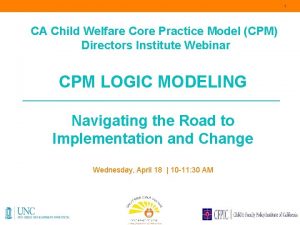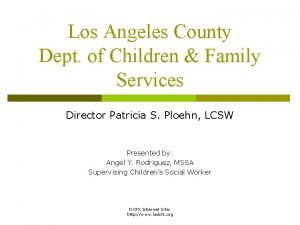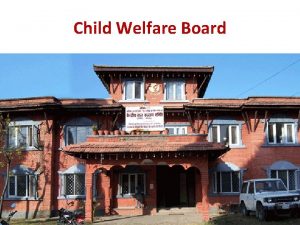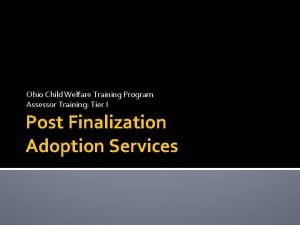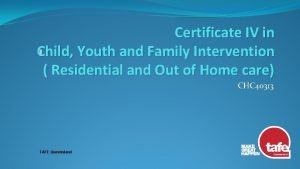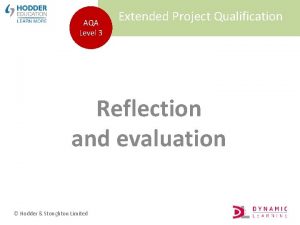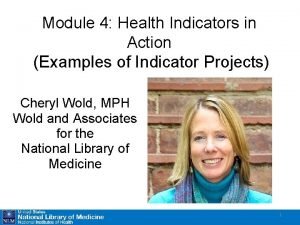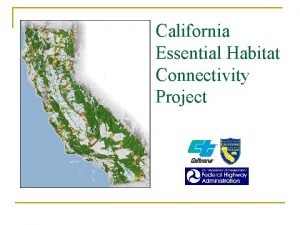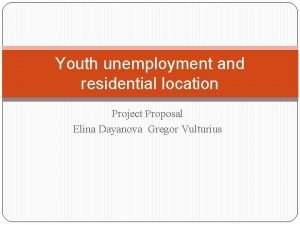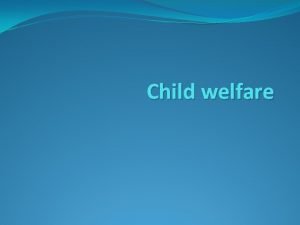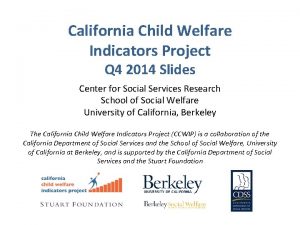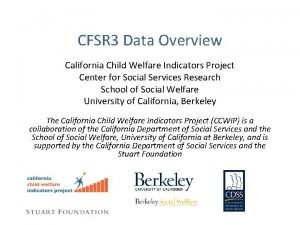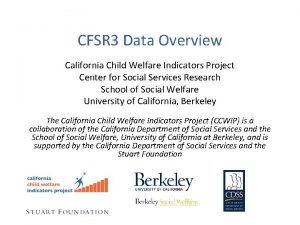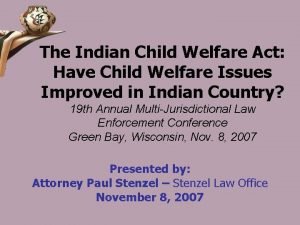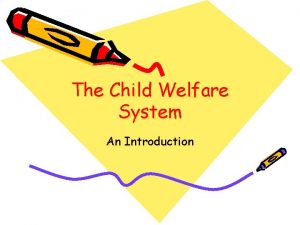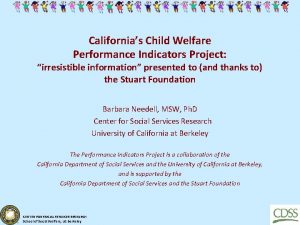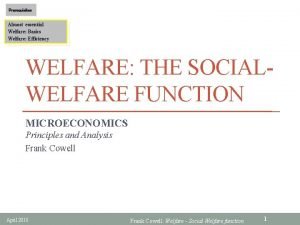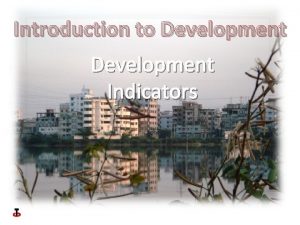California Child Welfare Indicators Project YOUTH IN EXTENDED






















- Slides: 22

California Child Welfare Indicators Project YOUTH IN EXTENDED FOSTER CARE Center for Social Services Research School of Social Welfare University of California, Berkeley The California Child Welfare Indicators Project (CCWIP) is a collaboration of the California Department of Social Services and the School of Social Welfare, University of California at Berkeley, and is supported by the California Department of Social Services and the Stuart Foundation

Research Questions? • How many youth age 18 -21 are in extended foster care (EFC)? • How has the number of youth age 18 -21 in foster care changed since the implementation of AB 12? • What are the demographic and case characteristics of youth in EFC? • Are there county differences in the percentage of foster youth in EFC? 1

How many youth age 18 -21 are in EFC? 2010 -2019 Youth Age 18 -21 Children In Care for 8 or More Days, by Agency Type 10, 000 9, 388 9, 000 9, 002 8, 343 8, 805 8, 311 8, 519 8, 411 7, 185 7, 437 7, 370 8, 000 7, 827 7, 000 5, 867 6, 000 7, 600 7, 473 6, 734 5, 000 4, 000 3, 133 3, 000 2, 871 3, 193 2, 670 3, 591 2, 828 1, 000 - 262 2010 520 2011 4, 665 760 2012 1, 199 2013 All 2 1, 605 1, 559 1, 400 1, 330 1, 125 1, 082 1, 041 2014 2015 2016 2017 2018 2019 Probation Child Welfare

How many youth age 18 -21 are in EFC? • As of July 1, 2019, 8, 411 youth age 18 -21 were in foster care in California. • Of these, 88 percent were child welfare supervised and 12 percent were probation supervised. 3

How many youth age 18 -21 are in EFC? 4

How has the number of youth age 18 -21 in foster care changed since the implementation of AB 12? • The number of youth age 18 -21 in foster care in California increased 188 percent between July 1, 2010 (2, 921) and July 1, 2019 (8, 411). • The number of youth age 18 -21 in foster care increased 182 percent among child welfare supervised youth and 246 percent among probation supervised youth. 5

Caseload Trends 2010 -2019 Caseload, Reentries, and Exits Youth Ages 18 -21, In Care for 8 or More Days 10, 000 9, 388 8, 000 9, 002 8, 343 8, 805 8, 519 8, 411 8, 311 7, 000 6, 000 5, 572 5, 657 5, 004 5, 867 5, 000 2, 000 1, 000 5, 313 4, 571 4, 499 4, 471 3, 591 4, 000 3, 000 5, 416 3, 149 3, 133 3, 193 35 25 2010 2011 3, 387 310 574 711 790 639 587 575 2013 2014 2015 2016 2017 2018 542 0 2012 Caseload 6 Reentries Exits 2019

Caseload Trends • The growth in the foster care caseload age 18 -21 is attributable to: a decline in exits, and an increase in reentries to foster care, immediately following implementation of AB 12. 7

Exit Trends 2010 -2018 Youth Age 18 -21 Exits from Foster Care for Youth in Care 8 or More Days, by Agency Type 6, 000 5, 657 5, 572 4, 721 4, 000 5, 416 5, 004 4, 471 4, 083 3, 000 3, 387 2, 542 2, 000 3, 149 4, 381 4, 167 5, 313 4, 571 4, 499 3, 552 3, 571 1, 019 928 4, 119 3, 320 2, 252 1, 000 841 917 845 895 2010 2011 2012 2013 1, 149 1, 272 2014 2015 1, 245 1, 193 0 Child Welfare 8 Probation 2016 All 2017 2018

Exit Trends • Exits from foster care among youth age 18 -21 declined 19 percent between 2010 (5, 572) and 2019 (4, 499). • Exits declined primarily among youth in child welfare supervised foster care. 9

Reentry Trends 2010 -2018 Youth Age 18 -21 Reentries to Foster Care for Youth in Care 8 or More Days, by Agency Type 900 790 800 711 700 639 587 574 600 569 500 472 465 400 10 435 428 262 200 0 458 542 310 300 100 575 593 197 35 109 30 25 25 2010 2011 142 167 129 140 48 0 2012 2013 2014 2015 Child Welfare Probation All 2016 2017 2018 114

Reentry Trends • Reentries to foster care among youth age 18 -20 rose for three years following implementation of AB 12 in 2012, and then started to decline, before stabilizing in 2017. In 2010, 35 youth age 18 -20 reentered care; in 2013, 574 youth reentered care; and by 2018, 575 youth reentered care. • Reentries following implementation of AB 12 were most common among youth in child welfare supervised foster care. 11

Youth Age 18 -21 In Foster Care on July 1, 2019 Race/Ethnicity Gender 2. 8 1. 2 27. 8 46. 3 53. 7 46. 9 21. 3 Black 12 White Latino Asian/P. I. Nat Amer Female Male

Youth Age 18 -21 In Foster Care on July 1, 2019 Time in Care Placement Type 10. 2 4. 9 9. 6 2. 8 5. 5 4 14. 3 35. 6 7. 8 24. 1 15. 3 11 40. 7 Relative/NREFM Foster FFA < 12 months 12 -23 months 24 -35 months Group/Shelter Guardian SILP 36 -47 months 48 -59 months 60+ months Transitional Housing Other 12 14. 2

Youth Age 18 -21 In Foster Care on July 1, 2019 Last Service Component Type 0. 1 0. 2 14 13. 7 71. 5 12 Emergency Response No Placement FM Post-Placement FM Family Reunification Permanent Placement Supportive Transition

What are the demographic and case characteristics of youth in EFC? • Black and Latino youth account for the majority of 18 -21 year olds in EFC. • Forty-one percent of 18 -21 year olds in EFC on July 1, 2019 were living in supervised independent living placements (SILP). Twenty-four percent were living in transitional housing. • Forty-seven percent of 18 -21 year olds in EFC on July 1, 2019 had been in care for 4 or more years. • Seventy-two percent of youth age 18 -21 receiving services on July 1, 2019 were in supportive transition. 16

Are there county differences in the percentage of foster youth in EFC? 2010 & 2019 Percentage of Foster Care Caseload Ages 18 -21 40. 0 35. 0 30. 9 30. 0 25. 0 19. 6 16. 3 17 ge le s Lo s La ss e n e s 3. 0 La k pe 2. 4 ng ria l t ld bo m en Hu Gl Im es no Fr 2019 1. 7 12. 1 7. 8 6. 7 4. 8 0. 4 n do rte 1. 1 2010 El N o ta De l os sa 2. 3 3. 3 Co nt Co lu s ve ra Ca la Bu e Am ad in Al p a m ed Al a 2. 2 1. 1 0. 0 tte 0. 0 4. 2 2. 9 2. 4 ra 2. 6 ra C 5. 0 10. 9 7. 1 Ki 5. 1 D o 6. 4 11. 2 9. 6 8. 5 8. 3 or 10. 0 13. 4 13. 0 A n 15. 0 10. 3 16. 8 15. 4 Ke rn 16. 1 yo 17. 0 In 20. 0

Are there county differences in the percentage of foster youth in EFC? 2010 & 2019 Percentage of Foster Care Caseload Ages 18 -21 40. 0 35. 0 30. 0 25. 0 17. 1 2010 2019 Be 2. 6 no Sa n Di eg o ar di to 4. 0 rn Be ni n Sa Sa n en to e am id 4. 8 3. 4 3. 0 Sa cr Ri Pl 8. 9 ve rs as 3. 4 um er e an g Or va da Ne pa y te re on on o M M od oc 0. 0 M er M en do cin o a os M M ar ip ar in M ce d 0. 0 0. 7 Na 1. 7 4. 1 3. 7 2. 3 ac 4. 1 4. 0 3. 5 ad er a M 8. 9 7. 1 0. 0 17 15. 2 14. 0 13. 5 11. 6 10. 1 5. 4 5. 0 16. 7 16. 4 15. 8 13. 5 15. 0 10. 0 18. 2 Pl 20. 0 20. 8 20. 7 19. 2 18. 6

Are there county differences in the percentage of foster youth in EFC? 2010 & 2019 Percentage of Foster Care Caseload Ages 18 -21 40. 0 33. 7 35. 0 30. 8 30. 0 25. 0 22. 5 19. 5 17. 8 10. 0 9. 7 10. 0 2. 7 3. 2 0. 0 nt Sa 2. 0 10. 1 3. 0 11. 8 8. 5 6. 1 3. 8 1. 4 2. 0 2. 6 2. 3 l Sa ara nt a C ru z Sh as ta Sie rra Sis kiy ou So la no So no m St a an isl au s Su tte Te r ha m a Tr in ity Tu la re Tu ol um ne Ve nt ur a 1. 7 a C ra ba ar eo at Sa nt a B M Sa n bi sp o in s O aq u Sa n Lu i Jo cis co n an Sa Fr n 4. 9 2. 0 1. 6 0. 0 Sa 8. 7 5. 1 4. 7 3. 4 5. 0 9. 8 2010 2019 14. 6 13. 1 12. 8 1. 2 3. 0 ba 15. 0 17 15. 7 14. 8 Yu 16. 7 lo 18. 9 Yo 18. 8 20. 0

Are there county differences in the percentage of foster youth in EFC? • The proportion of the foster care caseload age 18 -21 increased between 2010 and 2019 for all except four counties with small foster care populations. • The proportion of California’s foster care caseload age 18 -21 increased from 5 percent in 2010 to 14 percent in 2019. 20

Questions? For more information please contact: Stephanie Cuccaro-Alamin stephca@berkeley. edu Wendy Wiegmann wendy. wiegmann@berkeley. edu 22

http: //cssr. berkeley. edu/ucb_childwelfare Webster, D. , Lee, S. , Dawson, W. , Magruder, J. , Exel, M. , Cuccaro-Alamin, S. , Putnam-Hornstein, E. , Wiegmann, W. , Saika, G. , Chambers, J. , Hammond, I. , Sandoval, A. , Benton, C. , Hoerl, C. , Yee, H. , Flamson, T. , Hunt, J. , Carpenter, W. , Casillas, E. , & Gonzalez, A. (2019). CCWIP reports. Retrieved 11/20/2019, from University of California at Berkeley California Child Welfare Indicators Project website. URL: http: //cssr. berkeley. edu/ucb_childwelfare 23
 Core practice model
Core practice model Process indicators enable a software project manager to
Process indicators enable a software project manager to National health programme for children in india
National health programme for children in india National child policy 1974
National child policy 1974 International child welfare organizations
International child welfare organizations Agencies related to welfare services to the children
Agencies related to welfare services to the children Child welfare services
Child welfare services Central child welfare board
Central child welfare board Ohio child welfare training program
Ohio child welfare training program Child welfare
Child welfare Vr3 child welfare foundation
Vr3 child welfare foundation California youth football association
California youth football association Edcc dublin
Edcc dublin Environmental indicators of physical child abuse
Environmental indicators of physical child abuse Child, youth and family services act, 2017
Child, youth and family services act, 2017 Cert iv in child youth and family intervention
Cert iv in child youth and family intervention Extended project qualification aqa
Extended project qualification aqa Extended project lifecycle
Extended project lifecycle Extended project lifecycle
Extended project lifecycle Boston police
Boston police 승자트리
승자트리 California essential habitat connectivity project
California essential habitat connectivity project Project proposal on unemployment
Project proposal on unemployment
